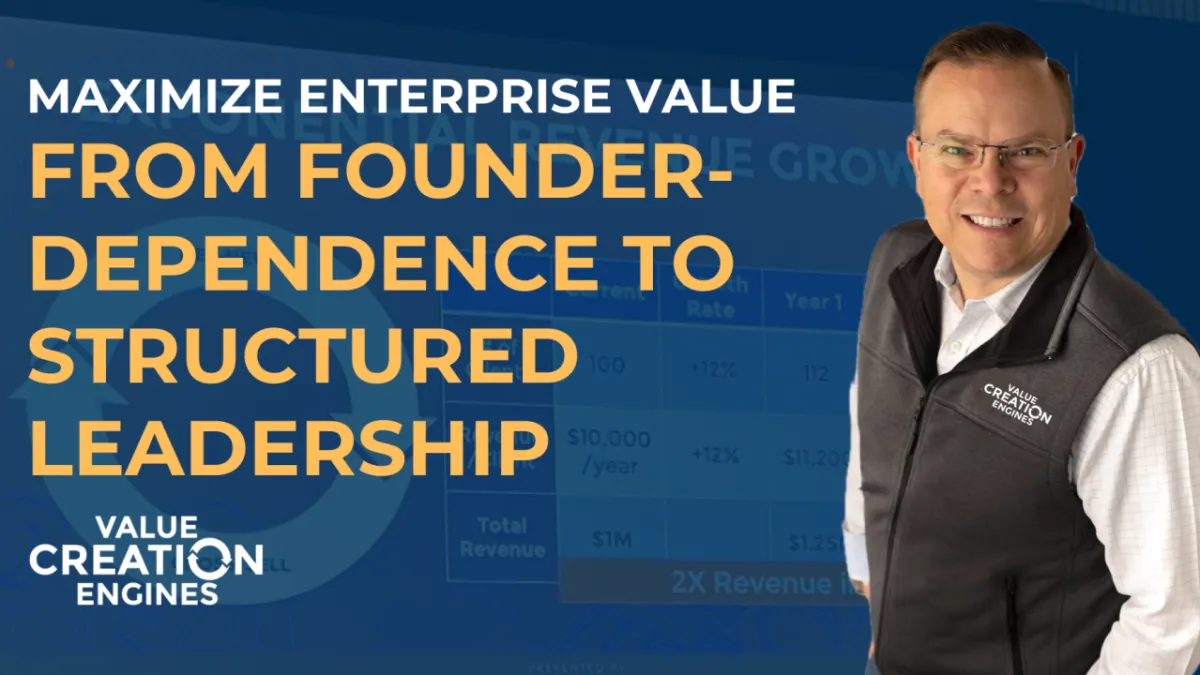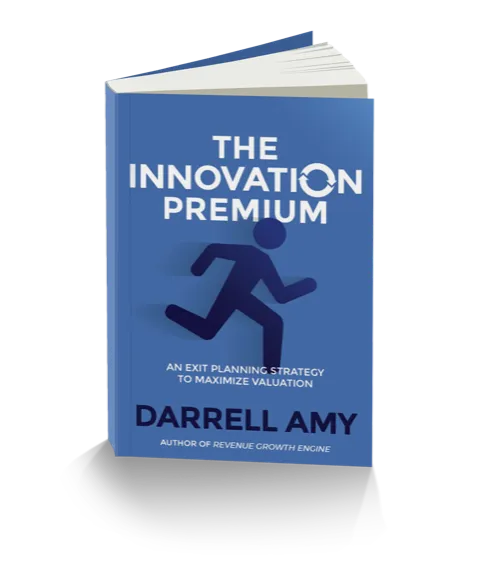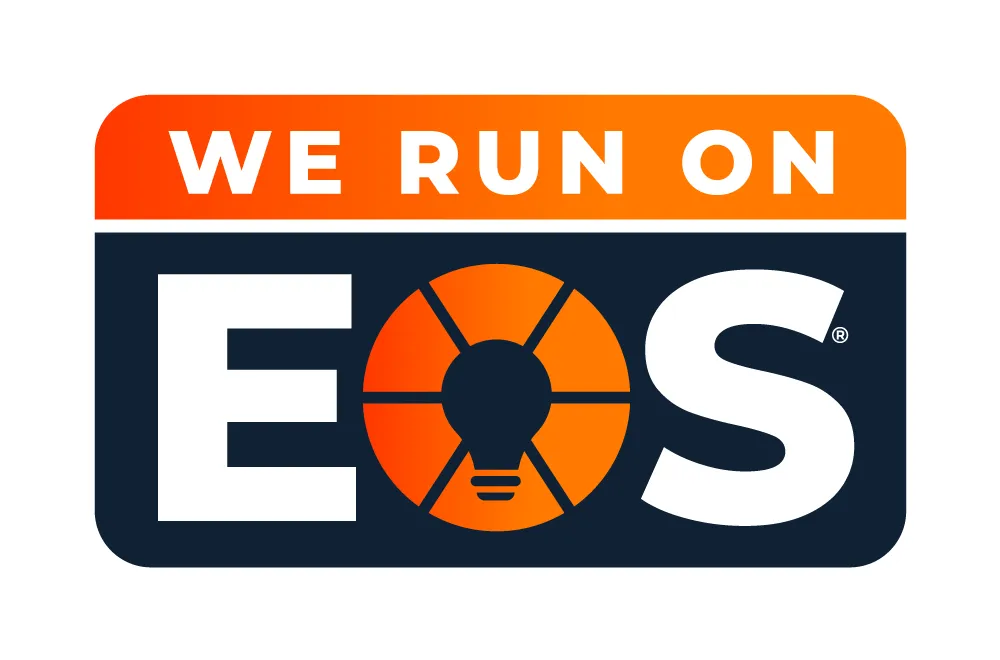THE VALUE CREATION BLOG

From Founder-Dependence To Structured Leadership
Founder dependence is the single greatest threat to a company's value. When potential buyers notice that essential operations are tied to the founder, they often lower their offers to mitigate risk, extending earn-outs with conditional payments as a safeguard. This reliance on the founder not only reduces the company's value but also complicates the sale process.
To enhance enterprise value, it's crucial to establish a strong, multi-layered leadership structure. This involves appointing capable leaders, clearly defining their responsibilities, providing the necessary resources, and holding them accountable for their performance. Founders may find it difficult to relinquish control, but by delegating authority to a second-in-command—such as an implementer in the EOS framework—they can ensure the business continues to thrive independently. This shift reassures potential buyers that the company is well-positioned to succeed without the founder at the helm.
The Impact of Founder-Led Companies
Transitioning a company away from founder dependence is essential for long-term success, but understanding the full impact of a founder-led organization is crucial in motivating this shift. Founder-led companies often face unique challenges that can significantly affect their freedom, financial health, and operational stability. In this section, we will explore the specific implications of founder dependence and why addressing these issues is vital for creating lasting value.
Freedom Implications
When the founder is deeply involved in daily operations, they experience a significant loss of freedom. Being central to the company's operation, they often feel unable to step away, even during vacations, as they remain tethered to their phone and laptop. If the company is sold, buyers worried about founder dependence will likely insist on an earn-out, requiring the founder to stay involved with the company when they likely wish to move on. Additionally, this arrangement puts some of the company's value at risk if it underperforms after the sale.
Financial Discount
Buyers account for founder dependence in their offers. A company heavily reliant on its founder will typically receive a lower offer, potentially leaving millions of dollars on the table. This discount reflects the additional risks and uncertainties that a buyer faces, knowing that the business's success is closely tied to a single individual. Buyers are also likely to factor in the costs and efforts needed to transition the company away from founder reliance, further driving down the overall offer. This financial penalty not only impacts the immediate sale price but can also affect the company's long-term valuation and growth potential.
Operational Risks
When the founder is central to business operations, the company is always at risk of disruption if the founder is unavailable. While some companies mitigate this risk by purchasing life insurance for key players, the insurance payout is rarely enough to replace a founder deeply involved in the operations.

Building a Multi-Tier Leadership Structure
Creating a multi-tier leadership structure is the key to overcoming the challenges posed by founder dependence. By developing a robust leadership team, founders can delegate essential responsibilities, freeing themselves to focus on strategic growth and preparing the company for future success. In this section, we'll outline the critical steps involved in building an effective leadership structure that enhances enterprise value and ensures the business can thrive independently of the founder.
1. Appoint a Second-In-Command
The first step is to appoint a strong leader to guide the company. The second-in-command assumes many of the founder's operational roles. Key functional leaders report to the second-in-command, freeing the founder from the responsibility of managing these people.
Having a second-in-command allows the founder to focus on strategy. If the company is not being sold, the founder can explore strategic ways to grow the business, such as through innovation or acquisitions. If the company is planning to sell within the next 3-5 years, the founder can begin preparing the company for sale. By freeing themselves from daily roles, they gain the time and space needed to get the company ready for the market.
2. Identify Key Roles and Responsibilities
Rethink the organization in light of the founder stepping back from operational roles. Identify the key roles the founder is currently handling that could be delegated. Map out the critical roles that need to be filled. Avoid the temptation to simply sketch out an organizational chart; ensure each role includes a list of specific accountabilities. The EOS framework does an excellent job of this with the Accountability Chart. Back up each role with a clear job description.
3. Delegate
With the leadership structure in place, the next step is for the founder to let go of the reins. This can feel very unsettling, which is why many companies fail at this stage. They create a leadership structure, but the nervous founder never truly allows the team to lead. This is a good time for the founder to hire a leadership coach to guide them through this challenging process.
4. Develop Leadership Talent
Simply placing people in roles is not enough. Companies must invest in their leaders. John Maxwell refers to this as "The Law of the Lid." If your top leader is a 6 out of 10, they will not be able to recruit and retain anyone better than a 6. The same applies to the leadership structure throughout the organization. Smart founders invest in their leaders, ensuring that each leadership position includes a growth plan.
Conclusion
Transitioning from founder dependence to a strong leadership structure is a critical step in maximizing enterprise value. By appointing a capable second-in-command, clearly defining roles and responsibilities, delegating authority, and investing in leadership development, founders can significantly reduce risks and enhance the attractiveness of their business to potential buyers. This not only frees the founder to focus on strategic growth but also ensures the company's long-term success, independent of the founder's direct involvement.
For more ideas on how to maximize enterprise value, read: Transform Your Company: Ten Smart Moves to Maximize Enterprise Value.
Originally published on Darrell Amy's LinkedIn.
This article is part of a series: Ten Smart Moves To Maximize Enterprise Value.
FREE BUSINESS VALUATION
What is Your Business Worth?
You can Discover the Value of Your Business in Less than 20 Minutes!
Join 70,000 business owners and get your score on the 8 Factors That Drive Your Company’s Value, a comprehensive analysis of your score and a detailed action plan for how to improve your score on each.


PREORDER YOUR FREE COPY NOW
Discover How to Create a Premium Valuation for Your Business
Learn how to command a premium multiple on your business
Find out why buyers discount their offers
See how innovation can help you create a premium valuation
Estimate your company's innovation index



